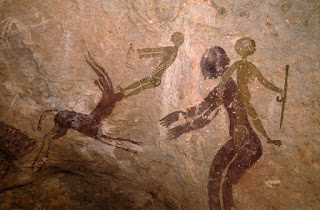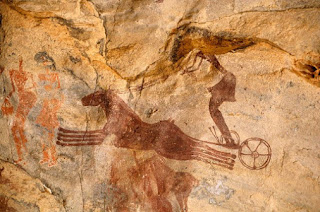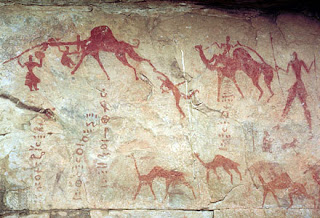The Tassili n Ajjer National Park was listed as a World Heritage Site in 1982 on account of its geological formations including ‘forests of stone’, biological diversity, archaeological importance and one of the richest rock-art areas on Earth. In 1986, UNESCO declared the area a Biosphere Reserve under its programme, Man and the Biosphere. It is second on the IUCN List of Protected Areas.
Warning ! Many Britishs and Europeans are kidnaped by Muslims Terrorists (Jihadists) in this area "Tassili" and Sahara desert of Algeria generally not secure, there is no signs of life for them. There is a lot of books, papers and youtubes video, just type in google : tassili n'ajjer rock art, cave painting sahara desert algeria ... and you will get tons of infos and pictures.
Prehistoric rock Art
The range is also noted for its prehistoric rock art of the indigenous, Aboriginal people of North Africa and Sahara (Ancient Berbers) and other ancient archaeological sites, dating from the Neolithic era when the local climate was less dry, savannah rather than desert. The art is no older than 9–10 millennia B.C, according to OSL dating of associated sediments, but may be younger.
The art depicts herds of cattle, large wild animals including crocodiles, geometric designs, Libyc and Tifinagh inscriptions (ancient and recent Tuareg/Berber script) and a very few plants and trees and human activities such as hunting and dancing. According to UNESCO, "The exceptional density of paintings and engravings...have made Tassili world famous as from 1933, the date of its discovery. 15,000 engravings have been identified to date."
Chronology of rock engravings :
Bubalus Period (or Large Wild Fauna Period) : 12,000 BC - 6,000 BC
The first of these is most commonly known as the Large Wild Fauna Period (10,000-6000 BC), others names include the Early Hunter Period and the Bubalus Period after a species of giant buffalo that became extict 5000 years ago. This era is caracterised by the portrayal of elephants, giraffes, crocodiles, hippopotamuses, rhinoceroses and lions from the time when the Sahara was covered by the plentiful savanna.
Round Head Period : 9,500 BC - 7,000 BC
The so-called Round Head Period (or ‘archaic period’), from approximately 9500 BC to 7,000 BC, is associated with schematic figures that evoke possible magic-religious practices. Generally, Round Head figures are seen in profile with round, often featureless heads, seemingly floating through space (depicted in the featured image and the picture below). In one scene, women are depicted with raised hands, as though seeking blessings from a huge figure that towers above them. Fabrizio Mori describes the scene: “We become aware, in them, of a sense of affectionate, fearless subjection (to the divine), of pure worship.” The art tends to portray and ethereal world where man is a part of nature rather than standing apart from it.
Pastoral Period : 7,200+ BC - 3,000 BC and possibly later
The Pastoral Period (or ‘Bovidian period’) from around 7,200 BC to 3,000 BC is the dominant period in terms of the number of paintings, during which there is the representation of bovine herds and the scenes of daily life. They have an aesthetic naturalistic realism to them and are among the best known examples of prehistoric mural art
Horse and Libyan-Warrior Period : 3,200 BC - 1,000 BC
The Horse and Libyan Warrior Period (‘Equidian period’), which dates from approximately 3200 BC to 1000 BC, covers the end of the Neolithic and protohistoric periods, which corresponds to the disappearance of numerous species from the effects of progressive desiccation and to the appearance of the horse. Horses have also been depicted pulling chariots, driven by whip-wielding unarmed charioteers, suggesting that the chariots were not used for fighting, but possibly for hunting. However, chariots with wooden wheels could not have been driven across the rocky Sahara and into the mountains where many of the chariot paintings occur.
Camel Period : 2,000 BC - 1,000 BC and later
The Camel Period introduces the last phases of rock art in the Sahara desert. Apart from camels, both engravings and paintings depict a few cows, herds of goats, mounted and dismounted men armed with spears, swords and shields, and a few wild animals, all somewhat crudely drawn. Maybe some of the earlier images are symbolic, but camel images may represent caravanserai, places where halts on long journeys were made. Images are often accompanied by Tifinagh, a later Lybico- Berber script still used by modern Tuareg.
 |
| Bubalus Period 12,000 BC - 6,000 BC |
 |
| Round Head Period 9,500 BC - 7,000 BC |
 |
| Horse and Libyan Warrior Period 3,200 BC - 1,000 BC |
 |
| Camel Period 2,000 BC - 1,000 BC |
 |
| Great God of Sefar - Tassili n'Ajjer |
 |
| Pastoral Period 7,200 BC - 3,000 BC |
References
- http://whc.unesco.org/en/list/179
- http://www.ancient-origins.net/ancient-places-africa/15000-artworks-over-ten-millennia-reveal-evolution-human-life-edge-sahara
- http://www.amusingplanet.com/2016/03/the-prehistoric-rock-art-of-tassili.html
- https://en.wikipedia.org/wiki/Tassili_n%27Ajjer
- OSL dating of quaternary deposits associated with the parietal art of the Tassili-n-Ajjer plateau - Mercier Norbert, Le Quellec Jean-Loïc, Hachid Malika, Agsous Safia, Grenet Michel (July 2012)
- Algeria - Anthony Ham, Nana Luckham, Anthony Sattin
- Rock Art of the Tassili n Ajjer, Algeria - David Coulson and Alec Campbell